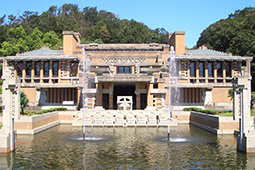INDEX
- English
- 日本語

The former Oya stone quarry at the Oya History Museum - English
- 日本語

Blocks of soft, hole-pocked Oya stone

Senju Kannon, one of ten Buddhist statues carved into a rock wall at Ooyaji Temple 
A lamp shade made from Oya stone 
Frank Lloyd Wright’s Imperial Hotel main lobby and entrance (reconstructed at Meiji Mura) showcase the qualities of Oya stone
October 2021
Oya Stone: Loved through the Ages

Utsunomiya City in Tochigi Prefecture is the production area of the highly-popular construction material, Oya stone. The culture of quarrying stone and using it in various ways has been passed down through the generations here. In 2018, “Utsunomiya, Home of Oya Stone Underground Adventure” was designated as a Japan Heritage site.

Oya stone is a rough, whitish tuff found exclusively in the town of Oya in Utsunomiya City, Tochigi Prefecture. Its soft texture and ease of processing has led it to be used in structures such as warehouses and stone walls in the environs of Utsunomiya City, many of which still stand today.
Tuff beds are believed to have formed as a result of a submarine volcanic eruption some fifteen million years ago. Tuff was also used to create the rock chambers of the burial mound clusters built in this area during the sixth and seventh centuries.
The Edo period (1603–late 1860s) saw the emergence of a trader who managed the entire process from mining to distribution, which led to Oya stone being used to build such structures as the stone walls of shrines and the walls of private homes. It was used to build Utsunomiya in such ways, creating the city’s characteristic appearance. The Oya stone mining industry flourished even more after the Meiji period (1868–1912), and with the development of railroads and other means of transportation, Oya stone was shipped in large quantities to Tokyo and Yokohama, where it was used to build cities as Japan modernized.
“In 1923, the Imperial Hotel’s main building [the Wright Building] was completed in Hibiya, Tokyo. The building was designed by American architect Frank Lloyd Wright, and was a unique construction of reinforced concrete and Oya stone. Instead of choosing granite or marble, Wright skillfully incorporated the soft and easy-to-process Japanese Oya stone into the building’s decorative features. However, on September 1 that year, the day the opening ceremony was held, the estimated-magnitude 7.9 Great Kanto Earthquake struck. The fact that this building that used Oya stone didn’t sustain serious damage in the earthquake made it famous for its superior earthquake resistance,” says Seiji Ryota of the Utsunomiya City Oya Stone Culture Promotion Council.

Later, the main lobby of the Wright Building was relocated to Meiji Mura (Meiji Village, an open-air museum) in Inuyama City, Aichi Prefecture, where the geometric patterned carvings, exposed pillars and walls, and other architectural features harnessing the soft texture and warmth of Oya stone have been preserved in their original form.
In the environs of Oya in Utsunomiya City, Tochigi Prefecture, there are places where visitors can get more familiar with Oya stone. One such attraction is Senju Kannon, the principal statue of the Buddhist temple Ooyaji Temple. Known as Ooya Kannon, the four-meter-high statue is said to have been made in 810 by Kukai, the founder of the Shingon sect of Buddhism. Carved directly into the rock wall of the temple hall are ten Buddha statues, including the principal Senju Kannon, which have been nationally designated as a Special Historic Site and as Important Cultural Properties.

As well as being used in traditional storehouses and stone walls, Oya stone is being used for new building applications, according to Fukuda Tomomi of the Utsunomiya City Oya Stone Culture Promotion Council.
“Lately, thin Oya stone panels have become a popular material for interiors. Oya stone is pocked with small holes, which makes it useful when it comes to controlling humidity. Used as a wall material, for example, it has the effect of maintaining a comfortable level of humidity inside a room.”
The Oya History Museum, which combines a small history museum and a huge disused stone quarry, is the perfect place to learn more about Oya stone. The labyrinthine former quarry also serves as a venue for concerts and exhibitions.

“In 2018, ‘Utsunomiya, Home of Oya Stone Underground Adventure’ was designated by the Agency for Cultural Affairs as a Japan Heritage site, in recognition of Utsunomiya’s Oya stone culture. Oya stone is a source of local pride and we would like to harness its appeal for tourism and industry to revitalize the town,” says Seiji.
Initiatives continue to make full use of the characteristics of Oya stone, a material loved through the ages.

